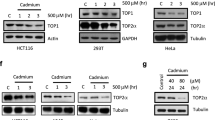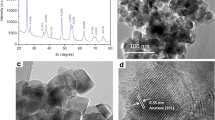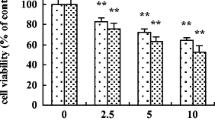Abstract
Glutathione (GSH) depletion sensitizes human lung carcinoma (A549-727) cells to the cytotoxic effects of Cd++. The effects of GSH depletion on Cd++ accumulation and Cd+-induced metallothionein (MT) content were investigated to determine the possible role of these Cd++ responses in the sensitization process. Cellular GSH was depleted to 20% to 25% of control levels with buthionine sulfoximine (BSO), or diethyl maleate (DEM), respectively. Neither treatment significantly affected Cd++-induced accumulation of exogenous35s-cysteine into intracellular MT in a dose-dependent fashion. The results indicate that neither enhanced Cd++ accumulation nor reduced MT synthesis plays a primary role in affecting enhanced Cd++ cytotoxicity in A549 cells with reduced GSH levels. Although BSO inhibition of GSH synthesis enhanced MT synthesis, it sensitized the cells to Cd++, which suggests an additive effect of GSH and MT in cadmium cytoprotection. This observation also raises the possibility that intracellular cysteine levels limit Cd++-induced MT accumulation rates.
Similar content being viewed by others
Abbreviations
- GSH:
-
glutathione
- MT:
-
metallothionein
- BSO:
-
DL-buthionine-[S,R]-sulfoximine
- DMSO:
-
dimethyl sulfoximine
- DEM:
-
diethyl maleate
- NP-40:
-
nonidet-P40
- PBS:
-
phosphate buffered saline
- HBSS:
-
Hank's balanced salt solution
- DTT:
-
dithiothreitol
References
Arrick, B.A., Nathan, C.F., Griffith, O.W. and Cohn, Z.A. (1982). Glutathione depletion sensitizes tumor cells to oxidative cytolysis. J. Biol. Biochem.257:1231–1237.
Biaglow, J.E., Varnes, M.E., Clark, E.P. and Epp, E.R. (1983). The role of thiols in cellular response to radiation and drugs. Radiation Res.95:437–455.
Bracken, W.M., Sharma, R.P. and Kleinschuster, S.J. (1984). Cadmium accumulation and subcellular distribution in relation to cadmium chloride induced cytotoxicityin vitro. Toxicology33:93–102.
Bruning, J.L. and Kintz, B.L. (1987). Computational handbook of statistics. (J.L. Bruning and B. J. Kintz, ed.), pp 174–180. Scott, Foresman and Company, Glenview, Illinois, London.
Christie, N.T. and Costa, M. (1984). In vitro assessment of the toxicity of metal compounds. IV. Disposition of metals in cells: Interactions with membranes, glutathione, metallothionein, and DNA. Biol. Trace Element Res.6:135–158.
Crook, T.R., Souhami, R.L., Whyman, G.D. and Mc Lean, A.E.M. (1986). Glutathione depletion as a determinant of sensitivity of human leukemia cells to cyclophosphamide. Cancer Res.46:5035–5038.
Dudley, R.E. and Klaassen, C.D. (1984). Changes in hepatic glutathione concentration modify cadmium-induced hepatotoxicity. Toxicol. Appl. Pharmacol.72:530–538.
Enger, M.D., Hildebrand, C.E., Walters, R.A., Seagrave, JC, Barham, S.S. and Hoagland, H.C. (1984). Molecular and somatic cell genetic analysis of metal resistance mechanisms in mammalian cells. In: Molecular and Cellular Approaches to Understanding Mechanisms of Toxicity. (A.H. Tashjian, ed.), pp 38–62. Published by the Harvard School of Public Health, Boston.
Enger, M.D., Rall, L.B. and Hildebrand, C.E. (1979). Thionein gene expression in Cd2+-variants of the CHO cell: correlation of thionein synthesis rates with thionein mRNA levels during induction, deinduction, and superinduction. Nucleic Acids Res.7:271–288.
Enger, M.D., Hildebrand, C.E., Seagrave, J.C. and Tobey, R.A. (1986). Cellular resistance to cadmium. In: Handbook of Experimental Pharmacology, Vol. 80 (E.C. Foulkes, ed.), pp 262–296. Published by Springer-Verlag, Berlin.
Hamilton, T.C., Winker, M.A., Louie, K.G., Batist, G., Behrens, B.C., Tsuruo, T., Grotzinger, K.R., Mc Koy, W.M., Young, R.C. and Ozols, R.F. (1985). Augmentation of adriamycin, melphalan, and cisplatin cytotoxicity in drug-resistant and sensitive human ovarian carcinoma cell lines by buthionine sulfoximine mediated glutathione depletion. Biochem. Pharmacol.34:2583–2586.
Jacobson, K.B. and Turner, J.E. (1980). The interaction of cadmium and certain other metal ions with proteins and nucleic acid. Toxicology16:1–37.
Kang, Y-J. and Enger, M.D. (1987). Effect of cellular glutathione depletion on cadmium-induced cytotoxicity in human lung carcinoma cells. Cell Biol. Toxicol.3:347–360.
Kang, Y-J. and Enger, M.D. (1987). Glutathione is involved in the early cadmium cytotoxic response in human lung carcinoma cells. Toxicology48:93–101.
Ketterer, B. (1982). The role of nonenzymatic reactions of glutathione in xenobiotic metabolism. Drug Metabolism Rev.13:161–187.
Kosower, N.S. and Kosower, E.M. (1978). The glutathione status of cells. Int. Rev. Cytol.54:109–160.
Laemmli, U.K. (1970). Cleavage of structural proteins during the assembly of the head of bacteriophage T4. Nature227:680–685.
Meister, A. and Anderson, M.E. (1983). Glutathione. Ann. Rev. Biochem.52:711–760.
Motulsky, J.J. and Ransnas, L.A. (1987). Fitting curves to data using nonlinear regression: a practical and nonmathematical review. FASEB J.1:365–374.
Perrin, D.D. and Watt, A.E. (1971). Complex formation of zinc and cadmium with glutathione. Biochem. Biophys. Acta230:96–104.
Seagrave, JC, Hildebrand, C.E. and Enger, M.D. (1983). Effects of cadmium on glutathione metabolism in cadmium sensitive and cadmium resistant Chinese hamster cell lines. Toxicology29:101–107.
Steel, R.G.D. and Torrie, J.H. (1980). Principles and procedures of statistics, a biometrical approach. (R.G.D. Steel and J.H. Torrie, ed.), pp 239–271. McGraw-Hill Book Company, New York.
Tietze, F. (1969). Enzymic method for quantitative determination of nanogram amounts of total and oxidized glutathione: Applications to mammalian blood and other tissues. Anal. Biochem.27:502–522.
Vallee, B.L. and Ulmer, D.D. (1972). Biochemical effects of mercury, cadmium, and lead. Ann. Rev. Biochem.41:91–128.
Wong, K-L. and Klaassen, C.D. (1981). Relationship between liver and kidney levels of glutathione and metallothionein in rats. Toxicology19:39–47.
Author information
Authors and Affiliations
Additional information
3. This work was presented in part at the 72nd Annual Meeting of the Federation of American Societies for Experimental Biology, Las Vegas, Nevada, May 1–5, 1988.
Rights and permissions
About this article
Cite this article
Kang, YJ., Clapper, J.A. & Enger, M.D. Enhanced cadmium cytotoxicity in A549 cells with reduced glutathione levels is due to neither enhanced cadmium accumulation nor reduced metallothionein synthesis. Cell Biol Toxicol 5, 249–259 (1989). https://doi.org/10.1007/BF01795354
Received:
Accepted:
Issue Date:
DOI: https://doi.org/10.1007/BF01795354




